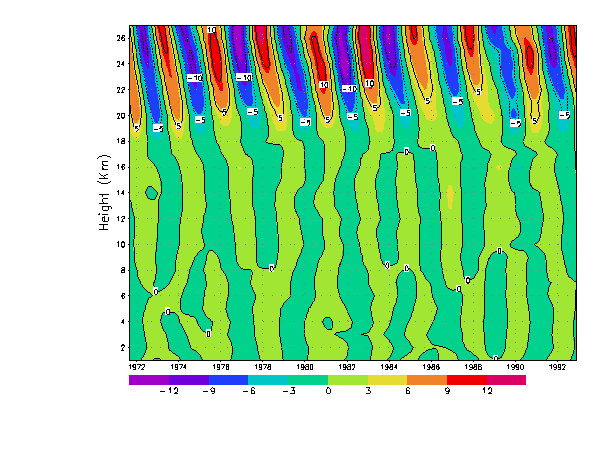
Previous: Link between QBO and TBO in Temperature Next: Conclusion Up: Ext. Abst.
QBO/TBO in Zonal Wind
Wavelet analysis is applied to zonal wind of Thumba for the same 256 month period as that of temperature to study the characteristics of QBO/TBO in it and compare them with those of temperature. In lower stratosphere, clear and regular QBO signal is seen in zonal wind (fig. 7). Phase of the zonal wind QBO propagates downward with uniform phase speed of about one km/month without any disturbance at any level. No significant variation is noticed in the maximum easterly and westerly amplitudes. Zonal wind QBO does not show marked difference between the two decades unlike in temperature.

Fig. 7 Time-height
plot of wavelet filtered zonal
wind corresponding to biennial mode.
Zonal wind hardly shows any TBO signal in the troposphere throughout the study period. As explained by Yasunari (1989), weaker TBO signal over Thumba in zonal wind is due to the location of Thumba near a node or small amplitude area of the wave no 1 or 2 structure of TBO mode around the globe.
Link between Monsoon Activity and Phase of QBO/TBO in Temperature and zonal wind
Thumba, located in the southern most part of the Indian peninsula is under strong influence of the Asian summer monsoon circulation. Our analysis shows a significant TBO signal in tropospheric temperature and prominent QBO signal in stratospheric temperature as well as zonal wind over Thumba. Recent studies reveal the existence of biennial time scale variability in Indian summer monsoon activity. According to Meehl (1987, 1997), Indian summer monsoon activity is strongly modulated by biennial time scale variability caused by atmosphere-ocean coupled processes occurring in the Indian and Pacific oceans. Convective activity is strong (weak) over the Indian ocean area (represented by Thumba data) during strong (weak) Indian monsoons. Kanamitsu and Krishnamurti (1978) pointed out a major shift in the circulation patterns from their normal position over Indian to southeastward during a drought year.
Table.1 gives data regarding ISMR for 1972-92. Of these years 1972, 1979, 1982 and 1987 are the weakest monsoons and 1975, 1983 and 1988 are
|
Year |
Indian
Summer monsoon Rainfall in mm (June-September) |
Percentage
departure from long term mean (1871-92) |
|
1972 |
652.6 |
-23.44 |
|
1973 |
913.4 |
7.16 |
|
1974 |
748.1 |
-12.24 |
|
1975 |
962.9 |
12.96 |
|
1976 |
856.8 |
0.52 |
|
1977 |
883.2 |
3.61 |
|
1978 |
909.3 |
6.68 |
|
1979 |
707.8 |
-16.96 |
|
1980 |
882.8 |
3.57 |
|
1981 |
852.2 |
-0.02 |
|
1982 |
735.2 |
-13.75 |
|
1983 |
955.7 |
12.12 |
|
1984 |
836.7 |
-1.84 |
|
1985 |
759.8 |
-10.86 |
|
1986 |
743.0 |
-12.83 |
|
1987 |
697.3 |
-18.20 |
|
1988 |
961.5 |
12.80 |
|
1989 |
866.7 |
1.68 |
|
1990 |
908.7 |
6.60 |
|
1991 |
784.6 |
-7.95 |
|
1992 |
784.9 |
-7.92 |
Table 1.
Indian Summer Monsoon Rainfall 1972-1992 (Parthasarathy et al. 1994)
the strongest monsoons of the period. During the 3 strong Indian monsoons the temperature TBO is in positive phase. Generally stratospheric zonal wind QBO is in westerly phase during strong Indian monsoon and easterly phase during weak Indian monsoons as pointed out by Bhalme et al, (1987). Of the 4 weak Indian summer monsoons except in 1979 TBO is in negative phase. The results suggest that the observed biennial variability in the tropospheric temperature over Thumba, may be due to the monsoon-ocean-atmosphere interactions taking place over Indian ocean region in biennial time scales as suggested by Meehl (1997).
Previous: Link between QBO and TBO in Temperature Next: Conclusion Up: Ext. Abst.